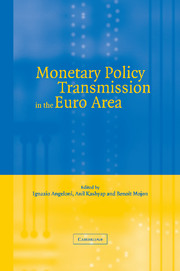 Monetary Policy Transmission in the Euro Area
Monetary Policy Transmission in the Euro Area Published online by Cambridge University Press: 22 September 2009
Introduction
The French monetary and financial markets were largely restructured in the 1980s, to allow in particular a better access of economic agents to market finance. However, bank-lending still remains a major source of finance for French firms and households. Then, a bank-lending channel is worth considering. Indeed, the population of Monetary and Financial Institutions (MFIs) is, in France as in many other countries, quite heterogeneous. Strong discrepancies can be observed across banks (e.g. in terms of legal structure, size and structure of their balance sheet) and information asymmetries between banks and their funds providers cannot be ruled out.
Unfortunately, previous work, based either on macro VAR models or on microeconometric estimates, is not very conclusive. In particular, Favero, Giavazzi and Flabbi (2001), in their comparative multinational study based on bank balance sheets from the BankScope database, do not find strong evidence of a bank lending channel in France. On the contrary, Martin and Rosenwald (1996) and Rosenwald (1998), using information about the rates at which banks issue CDs, find some differences across banks and thus cannot reject the existence of a lending channel. However, the latter find it to be of a rather small magnitude.
The present chapter fits, partly, in this literature. Its aim is to add a piece to the available evidence by looking at the way, depending on the banks' characteristics, the outstanding amount of bank loans responds to policy shocks.
To save this book to your Kindle, first ensure [email protected] is added to your Approved Personal Document E-mail List under your Personal Document Settings on the Manage Your Content and Devices page of your Amazon account. Then enter the ‘name’ part of your Kindle email address below. Find out more about saving to your Kindle.
Note you can select to save to either the @free.kindle.com or @kindle.com variations. ‘@free.kindle.com’ emails are free but can only be saved to your device when it is connected to wi-fi. ‘@kindle.com’ emails can be delivered even when you are not connected to wi-fi, but note that service fees apply.
Find out more about the Kindle Personal Document Service.
To save content items to your account, please confirm that you agree to abide by our usage policies. If this is the first time you use this feature, you will be asked to authorise Cambridge Core to connect with your account. Find out more about saving content to Dropbox.
To save content items to your account, please confirm that you agree to abide by our usage policies. If this is the first time you use this feature, you will be asked to authorise Cambridge Core to connect with your account. Find out more about saving content to Google Drive.